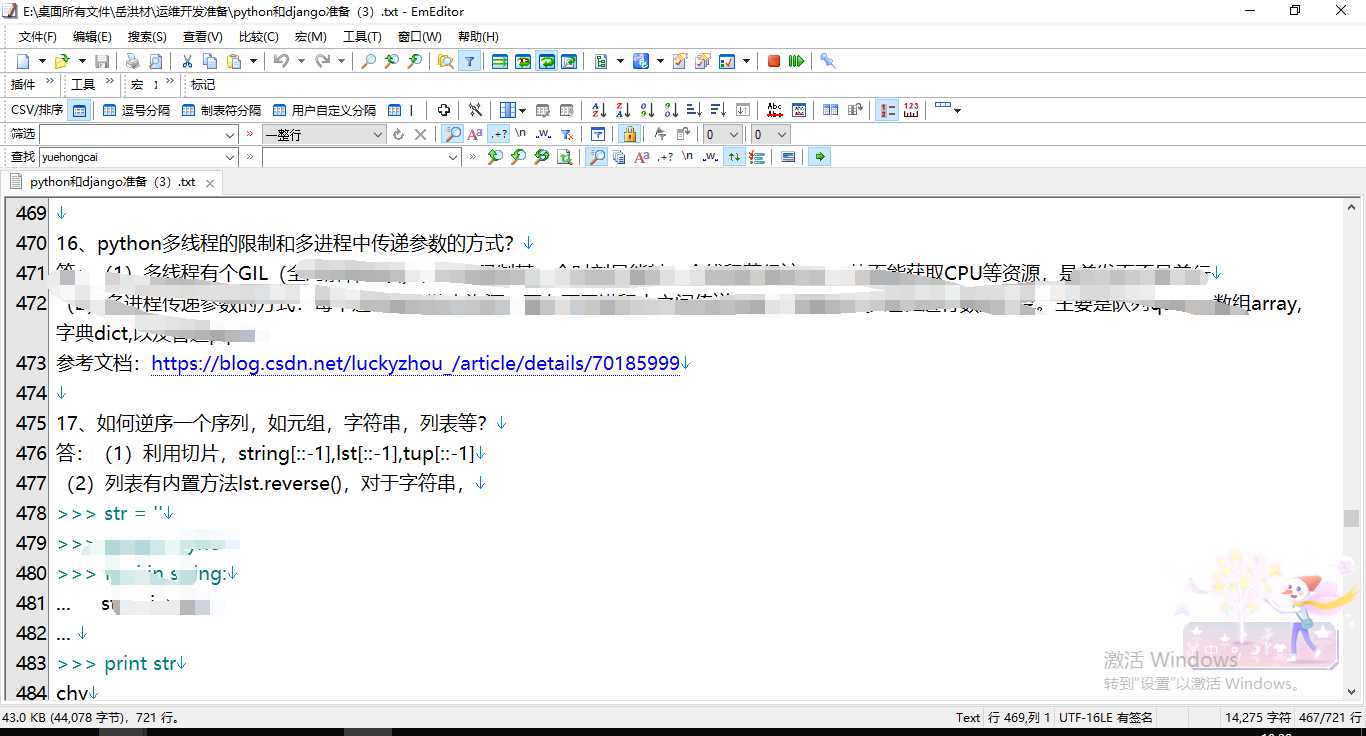python和web框架面试题目整理(3)
2020-12-28 07:28
YPE html>
标签:mysq 引号 ror lis 模块 css 信息 16px dismiss
1、django为什么需要缓存,有几种缓存方式?
答:由于Django是动态网站,部分请求均会去数据库进行相应的操作,当程序的访问量大时,耗时必然会更加明显,最简单解决方式是使用缓存提高读请求的处理效率。总共有6种缓存方式。
(1)搭建一个memcached服务器,监听在11211端口,然后在django所在机器上,安装一个python-memcached模块,在settings.py指定Cache字段中的Memcached守护进程的IP地址和端口,如果memcached安装在本机上面,那么也可以使用memcached的unix套接字。
(2)创建数据库缓存表,在settings.py中指定后端存储的引擎和数据表名,然后执行python manage.py createcachetable,默认使用default数据库
(3)基于文件系统的缓存,文件引擎会序列化各个缓存的值,将其存入指定的文件中
(4)本地内存缓存,不适合生产环境
(5)虚拟缓存,供开发调试,但它并不真正进行缓存,只是实现了缓存接口。
参考文档:《精通django》
https://www.cnblogs.com/LiCheng-/p/6920900.html
2、django中如何上传文件?
答:大体而言,一般有两种方式可以上传文件,分别是form表单提交到后台和通过ajax提交到后台
(1)方式一:form表单上传到后台
[root@k8s-master ~]# cat upload.html
[root@k8s-master ~]# cat forms.py
class FileForm(forms.Form):
ExcelFile = forms.FileField()
[root@k8s-master ~]# cat models.py
class UploadFile(models.model):
userid = models.CharField(max_length=30)
file = models.FileField(upload_to=‘./upload‘) # 在app下新建一个upload目录
date = models.DateTimeField(auto_now_add=True)
[root@k8s-master ~]# cat views.py
from .forms import *
def uploadFile(request):
uf = forms.FileForm(request.POST,request.FILES) # 在视图中实例化forms.py的类
if uf.is_valid():
upload = models.UploadFile()
upload.userid = 1
upload.file = uf.cleaned_data[‘fafafa‘] # fafafa是前端form表单中的文件name属性
upload.save()
print upload.file
return render(request, ‘upload.html‘, locals())
方式二:通过ajax上传文件
[root@k8s-master ~]# cat upload.html
$("#addBtn").on(‘click‘,function(){
$(‘#addModal‘).modal(‘show‘)
});
$("#submitbtn").click(function () {
FileUpload()
});
function FileUpload() {
var form_data = new FormData();
var file_info =$(‘#file_upload‘)[0].files[0];
form_data.append(‘file‘,file_info);
//if(file_info==undefined)暂且不许要判断是否有附件
//alert(‘你没有选择任何文件‘);
//return false
$.ajax({
url:‘/assets/upload/‘,
type:‘POST‘,
data: form_data,
processData: false, // tell jquery not to process the data
contentType: false, // tell jquery not to set contentType
success: function(callback) {
swal({
title:"success",
text:"添加成功",
type:"success",
confirmButtonText:‘确定‘
},function(){
$(‘#addModal‘).modal(‘hide‘)
window.location.reload();
})
}
});
}
});
[root@k8s-master ~]# cat views.py
from django.views.decorators.csrf import csrf_exempt
@csrf_exempt
def upload_ajax(request):
if request.method == ‘POST‘:
file_obj = request.FILES.get(‘file‘) # 前端div中input标签的name属性
path = ‘../../uploads/‘
import os
if not os.path.exists(path):
os.makedirs(path)
f = open(path, ‘wb‘) #可能需要使用r代表raw
print(file_obj,type(file_obj))
for chunk in file_obj.chunks():
f.write(chunk)
f.close()
return render(request,‘assets/index.html‘)
参考文档:http://www.cnblogs.com/liyqiang/articles/7858523.html
3、python2与python3有何区别?
答:(1)print带不带括号问题
(2)python3可以使用带有*号的变量,比如*x,y=[1,2,3]==>x=[1,2],y=3
(3)input与raw_input
(4)新式类与经典类
4、如果一个可迭代对象的元素个数超过变量个数时,会抛出一个ValueError 。那么怎样才能从这个可迭代对象中解压出N个元素出来?
答:使用星号表达式
>>> lst = [1,2,3,(4,5)]
>>> head,*middle,tail = lst
>>> head
1
>>> middle
[2,3]
>>> tail
(4,5)
5、在一个文本打印具有‘welcome‘关键字样的前5行?
答:保留有限历史记录正是collections.deque大显身手的时候。在写查询元素的代码时,通常会使用包含yield表达式的生成器函数,这样可以将搜索过程代码和使用搜索结果代码解耦。
#coding: utf-8
import sys
from collections import deque
def search(file_obj,pattern,history=5):
prelines = deque(maxlen=history) # deque()是个类,本质是个队列,先进先出,history代表队列容量大小
for line in file_obj:
if pattern in line:
yield line,prelines # 保留此次的结果值,除非调用一次函数,打印一次结果值
prelines.append(line) # 打印没有匹配到模式的前五行,因为如果有之前行的,都会被删除,只会保留最新5行
if __name__ == ‘__main__‘:
with open(r‘web.log.txt‘) as f:
result = search(f,‘welcome‘,5) # 过滤含有welcome字段的前5行,返回的是生成器
for line,prelines in result: # 参考yield返回值,用来迭代
for i in prelines:
print i # 先打印前几行的内容
print line # 打印关键字的当前行
sys.exit()
print ‘没有搜索到关键字!‘
参考文档:http://python3-cookbook.readthedocs.io/zh_CN/latest/c01/p03_keep_last_n_items.html
6、如何在一个列表或元组或集合中,快速搜素最大和最小的N个元素呢?字典中如何处理这样的含有数字的键值对呢?
答:heapq模块能够很好的解决这类问题,返回的结果都是列表。heapq模块底层实现是堆排序(构造一个完全二叉树,父节点始终大于子节点)
>>> import heapq
列表:>>> lst = [1, 8, 2, 23, 7, -4, 18, 23, 42, 37, 2]
>>> print heapq.nsmallest(3,lst) # 这里的3代表N,前3个或后三个
[-4, 1, 2]
>>> print heapq.nlargest(3,lst)
[42, 37, 23]
元组:>>> tup = (1, 8, 2, 23, 7, -4, 18, 23, 42, 37, 2)
>>> print heapq.nsmallest(3,tup)
[-4, 1, 2]
>>> print heapq.nlargest(3,tup)
[42, 37, 23]
>>>
集合:>>> jihe = set([1, 8, 2, 23, 7, -4, 18, 23, 42, 37, 2])
>>> print heapq.nsmallest(3,jihe)
[-4, 1, 2]
>>> print heapq.nlargest(3,jihe)
[42, 37, 23]
>>>
字典:>>> profile = [
{‘name‘: ‘IBM‘, ‘shares‘: 100, ‘price‘: 91.1},
{‘name‘: ‘AAPL‘, ‘shares‘: 50, ‘price‘: 543.22},
{‘name‘: ‘FB‘, ‘shares‘: 200, ‘price‘: 21.09},
{‘name‘: ‘HPQ‘, ‘shares‘: 35, ‘price‘: 31.75},
{‘name‘: ‘YHOO‘, ‘shares‘: 45, ‘price‘: 16.35},
{‘name‘: ‘ACME‘, ‘shares‘: 75, ‘price‘: 115.65}
]
>>> print heapq.nsmallest(3,profile,key=lambda x:x[‘price‘])
>>> print heapq.nlargest(3,profile,key=lambda x:x[‘price‘])
参考文档:http://python3-cookbook.readthedocs.io/zh_CN/latest/c01/p04_find_largest_or_smallest_n_items.html
7、如何实现一个具有优先级的队列,队列优先级最高的元素将会率先弹出,优先级相同的元素,按照队列先入先出的方式进行弹出?
答:heapq模块同样能实现队列,heappush和heappop来实现队列的插入和删除操作
#coding: utf-8
import heapq
class PriorityQueue():
def __init__(self):
self._queue = []
self._index = ()
def push(self,item,priority):
heapq.heappush(self._queue,(-priority,self._index,item))
‘‘‘
-priority代表从高到低进行排序,_index变量是为了比较相同优先级的元素,按照先进先出的方式弹出
‘‘‘
self._index += 1
def pop(self):
return heapq.heappop(self._queue)[-1] # heappop默认弹出最小的元素,-1是为了倒序弹出最大优先级的元素
class Item():
def __init__(self,name):
self.name = name
def __repr__(self): # __repr__方法是为了直接输出对象和print对象的时候,能够按照如下预定义的方式返回
return ‘Item(%s)‘ .format(self.name)
-------------------------------------------------------
>>> q = PriorityQueue()
>>> q.push(Item(‘foo‘), 1)
>>> q.push(Item(‘bar‘), 5)
>>> q.push(Item(‘spam‘), 4)
>>> q.push(Item(‘grok‘), 1)
>>> q.pop()
Item(‘bar‘)
>>> q.pop()
Item(‘spam‘)
>>> q.pop() # 优先级相同,但是foo元素先入队列,所以先出
Item(‘foo‘)
>>> q.pop()
Item(‘grok‘)
>>>
参考文档:http://python3-cookbook.readthedocs.io/zh_CN/latest/c01/p05_implement_a_priority_queue.html
8、字典有序不?如果无序,如何把它变成有序的呢?
答:字典本身是午休的,可以通过collections模块的OrderDict类是一个字典的元素保持有序。
#coding: utf-8
import collections
import json
d = collections.OrderedDict()
d[‘yhc‘] = 1
d[‘ly‘] = 4
d[‘lxx‘] = 3
d[‘zlx‘] = 2
>> print d
print json.dumps(d)
OrderedDict([(‘yhc‘, 1), (‘ly‘, 4), (‘lxx‘, 3), (‘zlx‘, 2)])
{"yhc": 1, "ly": 4, "lxx": 3, "zlx": 2}
9、如何在一个列表中搜索是否含有或相似某个元素呢?
答:
#coding: utf-8
import sys
import urllib2
import re
def search_elem(lst,item):
for line in lst:
if re.findall(item, line):
print line
print ‘存在‘
sys.exit()
print ‘不存在‘
lst = dir(urllib2)
search_elem(lst,‘request‘)
10、python字典对象和json如何转换,它们之间有何区别?
将字典{"a": 1, "b": "str", "c":[2, 3], "d":{"e": 4}}
转化为如下格式:
{
"a": 1,
"c": [
2,
3
],
"b": "str",
"d": {
"e": 4
}
}
答:(1)json.dumps是将字典对象转换为json,而json.loads是将json转换为字典对象
(2)json本质上一种字符串,它是一种数据格式,而字典是python对象(数据结构),有众多的调用方法;
(3)json的key值必须是双引号,而dict的key值可以是双引号,也可以使单引号
import json
d1 = {"a": 1, "b": "str", "c":[2, 3], "d":{"e": 4}}
print type(d1)
j1 = json.dumps(d1, indent=2) # indent=2代表子节点比父节点前多几个空格
print type(j1)
print j1
>>>
>>>
参考文档:https://blog.csdn.net/GitzLiu/article/details/54296971
11、如何用前端展示远程远程服务器的日志信息?
答:web框架依然使用django,源端通过websocket来发送日志到显示端,也可以从显示端去远程拉取。或者前端写一个js定时器,不断的发ajax请求到后台,每回取出一段日志
[root@k8s-minion ~]# cat server.py
#coding: utf-8
‘‘‘
pip install websocket-client
‘‘‘
users = set() # 连接进来的websocket客户端集合
def chat(ws):
user.add(ws)
while True:
msg = ws.receive() # 接收客户端的信息
if msg:
for u in users:
user.send(msg) # 发送消息给所有客户端
else:
break
users.remove(ws) # 如果有客户端断开连接,则踢出users集合
[root@k8s-minion ~]# cat client.py
#coding: utf-8
import subprocess
import time
import urllib
import os,sys
collect_log = ‘/var/log/message‘
socket_server = ‘www.socket.com‘ # 因为是从agent端推送数据,所以最好使用hosts或dns解析到显示端的IP地址
uri = ‘/djangweb/log‘
cmd = ‘/usr/bin/tailf collect_log‘
url = "http://%s%s" %(socket_server,uri) # django监听的url,这里默认python manage.py runserver 0:80
def send_log():
if not os.path.exists(collect_log):
sys.exit()
try:
res = subprocess.Popen(cmd,stdout=subprocess.PIPE,stderr=subprocess.PIPE,shell=True)
print ‘正在发送数据至[%s]...‘ %url
log_data = res.stdout.read().strip()
data = {‘log_data‘:json.dumps(log_data)}
value = data.encode(‘utf-8‘)
host_request = urllib.request.Request(url,value)
response = urllib.request.urlopen(host_request)
message = response.read().decode()
print ‘返回结果:%s‘ %message
except Exception as e:
message = ‘发送失败‘
print ‘\033[31;1m发送失败,%s\033[0m‘ %e
if __name__ == ‘__main__‘:
send_log()
[root@k8s-minion ~]# cat display_log.html # 这个页面的方面在django的urls.py和views.py自行定义
参考文档:https://www.linuxidc.com/Linux/2015-02/113356.htm
12、如何对字典中的value元素进行排序,求最大值和最小值呢?
如:d1 = {‘b‘:2,‘a‘:1,‘c‘:3}
答:zip函数是分别将两个可迭代的对象的元素组合成多个元组,然后构成一个新的列表。
>>> zip(d1.values(),d1,keys()) # 首先进行key-value的反转,keys()和values()方法返回的是两个键和值组成的列表
[(1, ‘a‘), (3, ‘c‘), (2, ‘b‘)]
>>> min(zip(d1.values(),d1.keys())) # 如果多个元素的键所对应的值相同,那么也只会返回一个元素,这个元素根据键大小
(1, ‘a‘)
>>> max(zip(d1.values(),d1.keys()))
(3, ‘c‘)
>>> sorted(zip(d1.values(),d1.keys())) # zip函数返回的是一个列表,可以利用内置函数sorted对它进行排序
[(1, ‘a‘), (2, ‘b‘), (3, ‘c‘)]
13、Python如何消除文件的重复行,并直接打印出来?(subprocess调用shell命令,uniq -c命令能实现)
答:思想还是采用集合方法。
def del_duplicate_line(seq):
seen = set()
for item in seq: # item代表文件的每一行
if item not in seen:
yield item ## 执行到此,停止
seen.add(item) ## 保留上一次item的结果,放到下一次运行
def main(file):
with open(file,‘r‘) as f:
for line in del_duplicate_line(f): # 返回的是一个生成器,用for循环迭代出来
print line
if __name__ == "__main__":
file = ‘service_conf.txt‘
main(file)
14、统计列表中每个元素的出现次数,并且打印出现次数最多的3个?
答:运用collections模块的Counter方法即可。Counter能处理字典和列表,同时还支持数学的加法,统计所有元素的出现次数
#coding: utf-8
from collections import Counter
words = [
‘look‘, ‘into‘, ‘my‘, ‘eyes‘, ‘look‘, ‘into‘, ‘my‘, ‘eyes‘,
‘the‘, ‘eyes‘, ‘the‘, ‘eyes‘, ‘the‘, ‘eyes‘, ‘not‘, ‘around‘, ‘the‘,
‘eyes‘, "don‘t", ‘look‘, ‘around‘, ‘the‘, ‘eyes‘, ‘look‘, ‘into‘,
‘my‘, ‘eyes‘, "you‘re", ‘under‘
]
count = Counter(words)
print ‘每个元素出现的次数是:%s‘ %count
top_three = count.most_common(3)
print ‘出现最多元素的前三名是:%s‘ %top_three
>>> a = {‘a‘:1,‘b‘:2}
>>> b = {‘b‘:3,‘c‘:4,‘a‘:5}
>>> Counter(a)
Counter({‘b‘: 2, ‘a‘: 1})
>>> Counter(b)
Counter({‘a‘: 5, ‘c‘: 4, ‘b‘: 3})
>>> Counter(b)+Counter(a)
Counter({‘a‘: 6, ‘b‘: 5, ‘c‘: 4})
15、在一个列表中,有数字元素和非数字元素,如何过滤出来所有数字元素,构成一个新的列表呢?
答:列表推导式可以过滤部分元素,另外内置函数filter方法也能进行过滤,比如filter(函数名,序列名)
#coding: utf-8
lst = [‘1‘, ‘2‘, ‘-3‘, ‘-‘, ‘4‘, ‘N/A‘, ‘5‘]
def is_int(values):
try:
x = int(values)
return True
except ValueError:
return False
res = list(filter(is_int,lst))
print res
>>> [‘1‘, ‘2‘, ‘-3‘, ‘4‘, ‘5‘]
此篇文章,还有25道题目,在我的面经中,详情看下面。
我会持续更新面试题目,包括linux,前端(vue,jquery,css)、python、mysql和redis的面经题目,后期加入golang。可以加我qq 2093905919或者微信 18828004657,跟我聊聊。(注:可以分享一部分面试题目,觉得可以的话,剩下的全部面试题目
多年经验,非常多而广的题目,适合突击面试复习,适合运维工程师,python工程师,运维开发,甚至前端开发(vue,asp,jquery)等等),需要打赏200元,绝对物超所值)

python和web框架面试题目整理(3)
标签:mysq 引号 ror lis 模块 css 信息 16px dismiss
原文地址:https://www.cnblogs.com/yue-hong/p/13029727.html
上一篇:Java-泛型,枚举,注解
下一篇:快速排序算法的性能比较